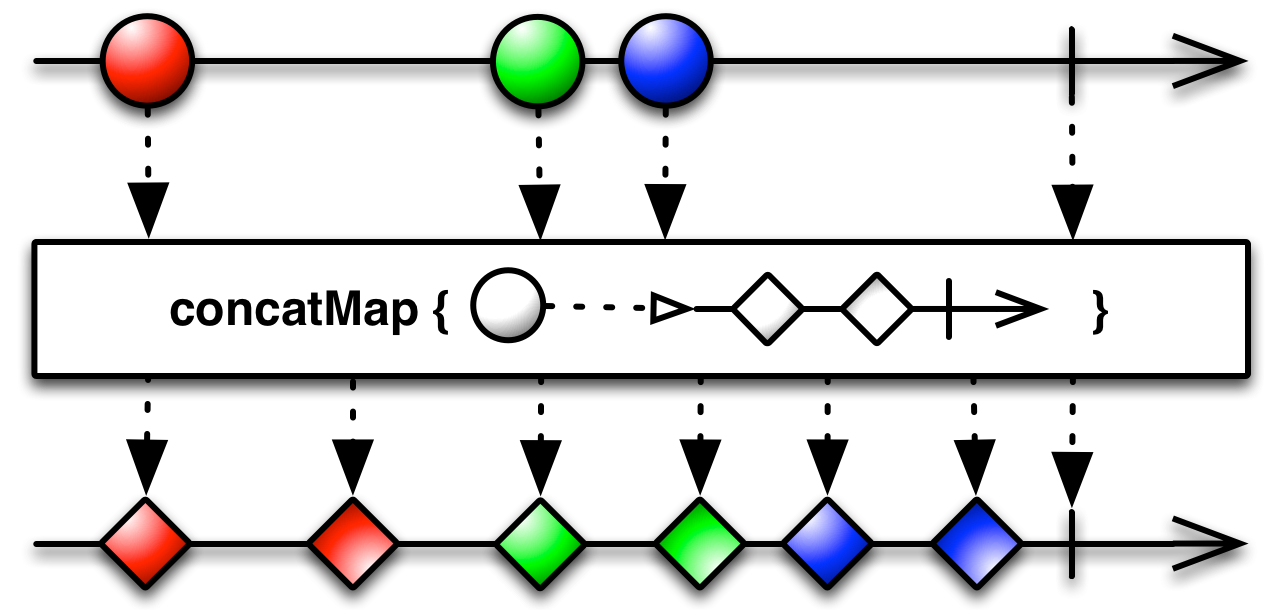Search results
concatMap :: forall a b. (a -> Array b) -> Array a -> Array bApply a function to each element in an array, and flatten the results into a single, new array.
concatMap (split $ Pattern " ") ["Hello World", "other thing"]
= ["Hello", "World", "other", "thing"]
concatMap :: forall a b. (a -> NonEmptyArray b) -> NonEmptyArray a -> NonEmptyArray bconcatMap :: forall a b. (a -> List b) -> List a -> List bApply a function to each element in a list, and flatten the results into a single, new list.
Running time: O(n), where n is the total number of elements.
concatMap :: forall a b. (a -> List b) -> List a -> List bApply a function to each element in a list, and flatten the results into a single, new list.
Running time: O(n), where n is the total number of elements.
concatMap :: forall a b. (a -> NonEmptyList b) -> NonEmptyList a -> NonEmptyList bconcatMap :: forall a b. (a -> NonEmptyList b) -> NonEmptyList a -> NonEmptyList bconcatMap :: forall a b. (a -> Seq b) -> Seq a -> Seq bO(m*n), where m is the number of sequences, and n is the length of the longest sequence within it. Map a function over a sequence and then flatten the results.
concatMap :: forall b a. (a -> Observable b) -> Observable a -> Observable bEquivalent to mergeMap (a.k.a, >>=) EXCEPT that, unlike mergeMap,
the next bind will not run until the ObservableImpl generated by the projection function (arg2)
completes. That is, composition is sequential, not concurrent.
Warning: if source values arrive endlessly and faster than their corresponding
inner ObservableImpls can complete, it will result in memory issues as inner
ObservableImpls amass in an unbounded buffer waiting for their turn to be subscribed to.

concatMap :: forall b a. (a -> ArrayView b) -> ArrayView a -> ArrayView bconcatMap :: forall b a. (a -> NonEmptyArrayView b) -> NonEmptyArrayView a -> NonEmptyArrayView bconcatMap :: forall b a. (a -> List b) -> List a -> List bApply a function to each element in a list, and flatten the results into a single, new list.
Running time: O(n*log(m), where n is the length of the given
list and m is the length of the lists returned by the function.
concatMap :: forall a f o i r. Foldable f => (i -> f o) -> Run (Transformer i o r) aComposition of map followed by concat.
concatMap :: forall b a. (a -> Observable b) -> Observable a -> Observable bEquivalent to mergeMap (a.k.a, >>=) EXCEPT that, unlike mergeMap,
the next bind will not run until the ObservableImpl generated by the projection function (arg2)
completes. That is, composition is sequential, not concurrent.
Warning: if source values arrive endlessly and faster than their corresponding
inner ObservableImpls can complete, it will result in memory issues as inner
ObservableImpls amass in an unbounded buffer waiting for their turn to be subscribed to.

concatMap :: forall b a. AsyncSubject a -> (a -> AsyncSubject b) -> AsyncSubject bEquivalent to mergeMap (a.k.a, >>=) EXCEPT that, unlike mergeMap,
the next bind will not run until the AsyncSubject generated by the projection function (arg2)
completes. That is, composition is sequential, not concurrent.
Warning: if source values arrive endlessly and faster than their corresponding
inner AsyncSubjects can complete, it will result in memory issues as inner
AsyncSubjects amass in an unbounded buffer waiting for their turn to be subscribed to.
concatMap :: forall b a. BehaviorSubject a -> (a -> BehaviorSubject b) -> BehaviorSubject bEquivalent to mergeMap (a.k.a, >>=) EXCEPT that, unlike mergeMap,
the next bind will not run until the BehaviorSubject generated by the projection function (arg2)
completes. That is, composition is sequential, not concurrent.
Warning: if source values arrive endlessly and faster than their corresponding
inner BehaviorSubjects can complete, it will result in memory issues as inner
BehaviorSubjects amass in an unbounded buffer waiting for their turn to be subscribed to.
concatMap :: forall b a. Observable a -> (a -> Observable b) -> Observable bEquivalent to mergeMap (a.k.a, >>=) EXCEPT that, unlike mergeMap,
the next bind will not run until the Observable generated by the projection function (arg2)
completes. That is, composition is sequential, not concurrent.
Warning: if source values arrive endlessly and faster than their corresponding
inner Observables can complete, it will result in memory issues as inner
Observables amass in an unbounded buffer waiting for their turn to be subscribed to.

concatMap :: forall b a. ReplaySubject a -> (a -> ReplaySubject b) -> ReplaySubject bEquivalent to mergeMap (a.k.a, >>=) EXCEPT that, unlike mergeMap,
the next bind will not run until the ReplaySubject generated by the projection function (arg2)
completes. That is, composition is sequential, not concurrent.
Warning: if source values arrive endlessly and faster than their corresponding
inner ReplaySubjects can complete, it will result in memory issues as inner
ReplaySubjects amass in an unbounded buffer waiting for their turn to be subscribed to.
concatMapTo :: forall c b a. AsyncSubject a -> AsyncSubject b -> (a -> b -> AsyncSubject c) -> AsyncSubject cThe type signature explains it best. Warning: Like concatMap, composition is sequential.
concatMapTo :: forall c b a. BehaviorSubject a -> BehaviorSubject b -> (a -> b -> BehaviorSubject c) -> BehaviorSubject cThe type signature explains it best. Warning: Like concatMap, composition is sequential.
concatMapTo :: forall c b a. Observable a -> Observable b -> (a -> b -> Observable c) -> Observable cThe type signature explains it best. Warning: Like concatMap, composition is sequential.

concatMapTo :: forall c b a. ReplaySubject a -> ReplaySubject b -> (a -> b -> ReplaySubject c) -> ReplaySubject cThe type signature explains it best. Warning: Like concatMap, composition is sequential.
No further results.